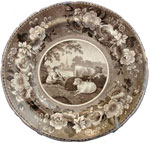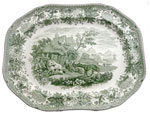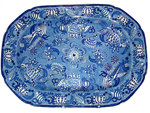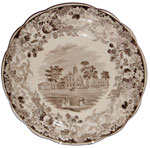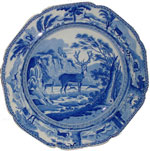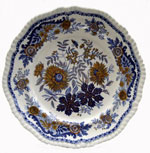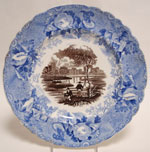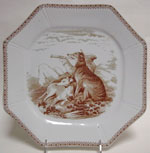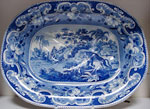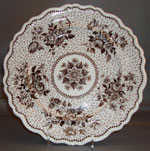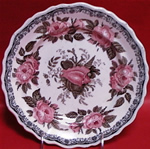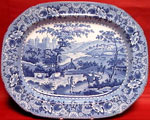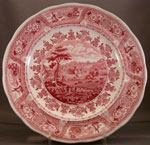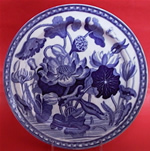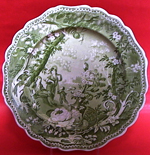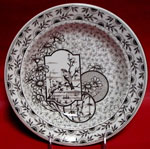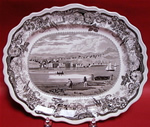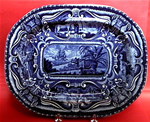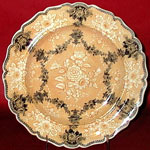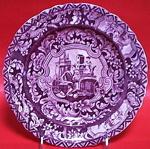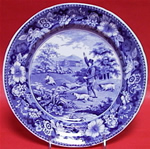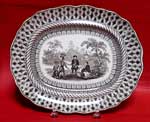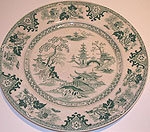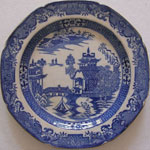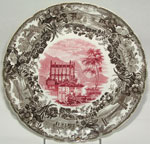Archived Patterns of the MonthFor the most recent patterns of the month, click here. Want to learn about other patterns? Find patterns in our Database. |
||
(Click on thumbnails to
|
"Domestic Cattle" |
 |
"Aesop's Fables, The Sow and the Wolf" This 16.5 inch by 13 inch platter was produced by Copeland & Garrett after 1833. The patterns in this series produced prior to 1833 had the word SPODE on the lower left part of the ribbon; however, that name has been covered over. The same copper plates were used by this successor to Spode. For more information about this platter and this series, see the database. |
 |
|
This 18.25 inch by 13 inch platter is printed in medium to dark blue with stylized shells and sea plants. The border is also designed with shells and sea plants surrounded by an underglaze blue line at the edge. The maker is unknown. The platter dates from around 1830. |
||
"Harvard College" by Enoch Wood & Sons (1818-1846).This 10.5 inch plate is printed in dark brown, and is from Wood's Celtic China series, probably circa 1835-1846. David and Linda Arman in Historical Staffordshire, An Illustrated Check-List (1974) list 18 views in this series. The series, printed in black, brown, purple, light blue, pink and green, portrays scenic views of historical America. |
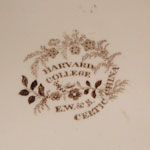 |
|
Known as "The Bewick Stag", this 9.5 inch pearlware plate is printed in underglaze blue by Minton. A General History of Quadrupeds (1790) by Thomas Bewick (1753-1828) pictures the Stag or Red Deer. He stands at the center of this earthenware dinner plate. Behind him are two smaller stags and, perhaps, a female deer. The border consists of vignettes which Bewick used on the his title pages or at the end of his descriptions of animals. Two have been identified. One is called "A Crouching Leopard Ready to Spring" c. 1792, which appears in the third edition of Quadrupeds, p. 92. The other is "Dogs Disputing", which appears in the 1826 edition of Bewick's Water Birds, p. 414. The other vignettes may also be by Bewick or by one of his apprentices. The "Crouching Leopard" vignette was used as the central pattern by other makers. |
||
"Chinese Market Stall." Maker Unknown. This pattern is shown on a pearlware well and tree platter measuring 13 5/8” by 18 1/4” and is printed in underglaze blue with overglaze clobbering in shades of rust red and ochre enameling on the edge. The added coloring is unusual on a pattern of this type. Found on the back is an impressed “18” mark indicating the size of the dish and a blue hand painted “X” printer's mark. The border incorporates geometric shapes and picture medallions. Examples are known both with and without the name 'Wear Sc.' at the end of a fence in the design. [Not present on this piece.] The pattern is frequently attributed to Andrew Stevenson of Cobridge, Staffordshire, on the grounds of its resemblance to other marked similar patterns. This pattern can be found the TCC pattern database. |
||
"Jasmine." Shown on an earthenware dinner plate with gadrooned edge, it is marked with both an impressed and a printed SPODE mark. The pattern is printed underglaze in blue and shades of warm brown. It is Spode's pattern B118 which was introduced in 1825. The Jasmine flower itself, for which the pattern gets its name, is actually found in the border. This pattern can be found on the TCC pattern database. |
||
"Fisherman" by Enoch Wood & Sons (1818-1846). This 7" plate is from the
1835-1846 period. Although this plate is printed in underglaze brown and blue, the pattern is also found printed in combinations of red and black, blue and black and red and green, and probably more color combinations! The factory also used different borders for this series, as well as different centers, a highly unusual occurrence. |
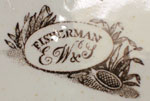 |
|
"Sporting Scenes" printed in underglaze brown by J.F. Wileman (1870-1892). |
||
Commonly known as either Sporting Series or Zoological Series, this 18-3/4" by 14-3/4" well and tree platter was made by Enoch Wood & Sons in Staffordshire around 1825. Each size in this series depicts a different animal that is being hunted. The tiger in the background on this platter appears to be hunting too! There is no pattern name marked on any of the items. Enlarged View |
||
"Brunswick Star" printed in underglaze brown by an unknown maker circa 1835. |
||
| "Moss Rose" pattern printed in underglaze brown, pink and black by John & Job Jackson (1831-1835). This is an unusual color combination. Enlarged View |  |
|
| "The Ladies of Llangollen" circa 1825 pearlware platter printed in underglaze blue. Although this platter is not marked, it was probably made by either the Cambrian (1783-1870) or Glamorgan (1813-1838) potteries, which were in business in Swansea, Wales. According to the Dictionary of Blue and White Printed Pottery 1780-1880, the ladies of the title ran away together in the late 18th century. They lived together in Llangollen, Wales for the next fifty years. Their cottage in Wales (nothing like the castle printed on the pottery) was a mecca for the British literati of the early 19th century. For more information about this interesting pattern, take a look at the pattern in the TCC database. Enlarged View | ||
"Clyde Scenery" printed in underglaze pink(red) by John & Job Jackson (1831-1835). The central pattern is different on each size and shape. The river Clyde runs through Glasgow, so that although this is an unidentified view, it is probably easy to research. The pattern is also printed in purple, black, brown, blue and teal green. Enlarged View
|
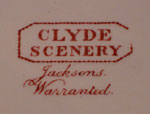 |
|
|
"Water Lily" printed in underglaze blue by Wedgwood (1759 to the present). According to Coysh and Henrywood in the Dictionary of Blue and White Printed Pottery 1780-1880, the pattern is also known as Lotus. The pattern was introduced in brown in 1808. It was first printed in blue, with a change to the border, in 1811. |
||
| "Zoological Sketches" printed on earthenware in underglaze black by Job Meigh & Son (1815-1832). The central animal pattern and the birds in the border are different on nearly each size and shape.
This soup tureen stand depicts a leopard. Other animals in the series are an elephant, a rhinoceros, an elk, a lion, a tiger, a skunk, a hyena, a zebra, a lemur, a gazelle, kangaroos, and more!
The pattern was also printed in blue. Enlarged view |
||
Commonly known as "Impatient Child," this pattern is printed on earthenware in yellow-green by an unknown maker. It was probably
made in Staffordshire around 1825-1830. The pattern is usually seen in blue. |
||
"Devonshire" pattern on earthenware in underglaze brown by Ridgways, Staffordshire, circa 1880. This plate is an example of Aesthetic
Movement
transferware. |
||
"Picturesque Views, Hudson, Hudson River" by James and Ralph Clews, printed in underglaze brown, Staffordshire circa 1835. The central view varies according to size. The views of the Hudson River area are taken from W.G. Walls's Hudson River Portfolio. There are also views from the Pittsburgh, Pennsylvania area. The series is also printed in black, light blue, pink (red) and purple. Enlarged view |
||
"Quadrupeds" by John Hall, printed in underglaze blue on earthenware, Staffordshire circa 1825. The central animal pattern and the animals in the border vary by size. This is a huge series filled with animals! Enlarged view |
||
| "Etruscan Festoon" by William Ridgway & Co., printed in underglaze yellow and black, Staffordshire circa 1835. This pattern is also seen in blue and black and pink and black. Enlarged View |
||
"Harp" by R. Stevenson, printed in underglaze purple, Staffordshire circa 1830. This pattern is mainly seen in dark bluee. Enlarged View |
||
"Game Keeper" on earthenware in underglaze blue by an unknown maker,
possibly Staffordshire, circa 1825. The backstamp features the
title printed on a dog collar! |
||
"W. Penns Treaty" on earthenware in underglaze brown by Thomas Green, Minerva Works, Fenton, Staffordshire, circa 1847. The central pattern varies by size. This is a 17" platter. The pattern was also printed in green, pink, black, and blue. Enlarged View |
||
| "The Rabbit on the Wall pattern" on earthenware from the "Wilkie's Designs" series in underglaze blue by James & Ralph Clews, Cobridge Works, Cobridge, Staffordshire, circa 1825. There are six other central patterns in this series. Enlarged View |
||
Shanghai pattern on ironstone printed underglaze in green by W. Adams & Sons, Tunstall, 1834-64. The pattern is also found in flown blue and enamelled with yellow luster. |
||
Long Bridge pattern |
||
Festoon Border |
||

